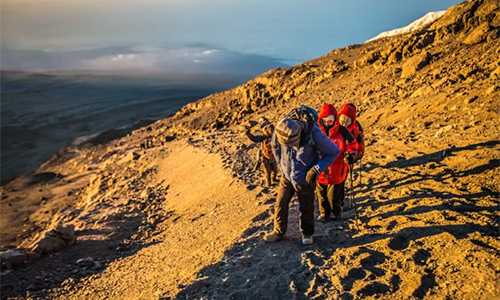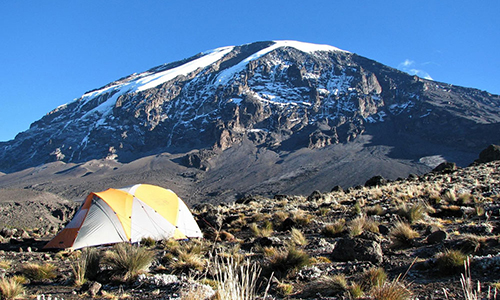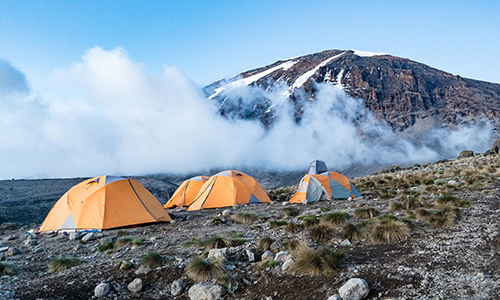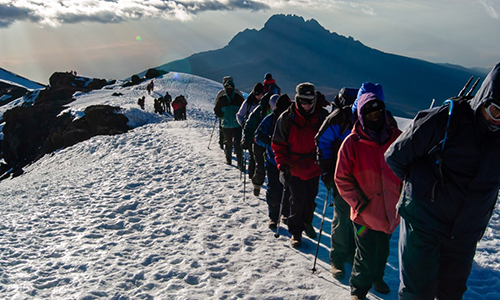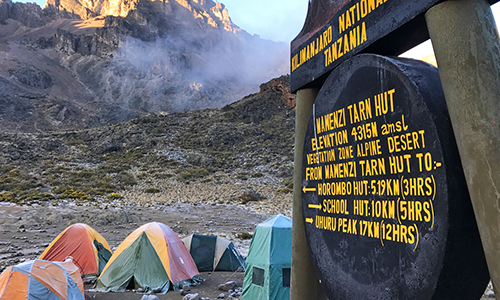Forfaits d'escalade du mont Kilimandjaro
Forfaits d'escalade du mont Kilimandjaro
Safaris au Kenya et en Tanzanie
Mount Kilimanjaro Climbing safari – Mount Kilimanjaro Climbing Packages
(Mount Kilimanjaro Climbing safari, Private Mount Kilimanjaro Climbing Safari, Safaris au mont Kilimandjaro)
Forfaits d'escalade du mont Kilimandjaro
Machame route is regarded as the most scenic of the trails up Kilimanjaro. You ascend gradually through the forest till you emerge onto the Moorland of Shira Plateau, from which there are superb views of the Kibo Peak and the Great Western Breach.
Kilimanjaro is a popular peak, high on the list of ultimate treks (along with Mt Everest and Machu Picchu in Peru), taken on by many who covet the title of climbing the tallest mountain in Africa. We humans love superlatives – the biggest, the tallest, the oldest. But do not be fooled into thinking that just because many have gone before you, it will be a walk in the park. Oh no – this is the most challenging thing I have ever done. But I couldn’t recommend it more.

Itinéraires en vedette
FAQ SUR LE MONT KILIMANDJARO ET LES MEILLEURS MOMENTS POUR FAIRE UNE RANDONNÉE
Where is Mount Kilimanjaro?
Kilimanjaro is located in the northeast of Tanzania, near the Kenyan border. It lies around 140 kilometres south of Nairobi (the Kenyan capital), and 500 kilometres northeast of Dodoma, Tanzania’s capital.
How do I get to Mount Kilimanjaro?
To get to Kilimanjaro you need to fly to Kilimanjaro International Airport (KIA). There are several direct flights from Europe (from Amsterdam and Zurich) and the Middle East (Doha and Turkey). But chances are you’ll need to fly via another African destination – Dar es Salaam, Arusha and Nairobi are your best bet.
A Mount Kilimanjaro hike will typically set off from one of two towns: Arusha, to the south west of the mountain, and Moshi, directly south. It takes around an hour to reach Moshi and 80 minutes to reach Arusha. The most common method of transportation is via taxi or prebooked shuttle – in many cases, however, your tour operator will meet you at the airport.
Quelle est la meilleure période pour gravir le mont Kilimandjaro ?
Mount Kilimanjaro sits in Kilimanjaro National Park. It’s 300km south of the equator – and Tanzania is iconically tropical, with wet seasons and and dry season variations laid over a hot muggy climate. So when is the best time to climb Kilimanjaro? Let’s take a look at the seasons and Kilimanjaro climbing season.
Tanzania experiences two rainy seasons: a short one in November to mid-December and the long rainy season from March to May. The routes on Mount Kilimanjaro can be wet and muddy underfoot during these seasons. If you care less about monsoonal weather and more about solitude, then you may prefer these times to climb as there are far fewer people. Although expect to get very damp.
July to October is peak time on the mountain, especially as it coincides with European summer holidays. This window of time is dry and cooler than the Christmas months, but prepare for some cold nights. If you want to enjoy similar weather, but with far fewer people, then Mid-May to June is an optimal time for you. It’s just before the holidays, but still peak climbing season.
December to February are much warmer and have good visibility. The short rainy season can run into December though so it may still be wet. These months also coincide with the Christmas holidays so it can still get busy.
How long does it take to climb Mount Kilimanjaro?
There are seven routes up Kilimanjaro, each of which takes between five and nine days. However, it’s very important not to rush the ascent as it could lower your success rate! The reason for this is because you need to ensure time for your body to acclimate to high altitude.
A slow, steady ascent gives your body time to adjust to high altitudes – where there is less oxygen in the air – if you race to the summit, you’re in danger of getting altitude sickness and having to leave the mountain.
Is it difficult to climb Mount Kilimanjaro?
Climbing Mt. Kilimanjaro is no small undertaking. It may be considered one of the easiest of the Seven Summits, but it’s still a 5895m mountain. Porters will be on hand to carry some of your kit, but you’ll still be wearing a daypack containing all the food, water and clothing you need for the day.
You can skip acclimatisation days and make very quick ascents on Kilimanjaro. But this is definitely not recommended. Altitude sickness is no joke on the mountain.
Can you climb Mount Kilimanjaro without a guide?
In 1991, the Tanzanian government and Kilimanjaro National Park passed a regulation that all trekkers must be accompanied by a registered and licensed guide. Trekkers need to register with the Parks Authority before setting out, and sign in at each camp – they are forbidden from wild camping or using caves for shelter. Rangers on the mountains will ensure that these rules are enforced.
You’ll also need to pay park entrance fees to climb Kilimanjaro. These might seem hefty, but they include a conservation fee – to help cover the cost of maintenance – campsite fees, and even a rescue fee (just in case). You can expect to pay around £600-£800 in park fees, depending on the duration of your trek. This needs to be provided to the park authorities in advance through your tour operator, rather than independently.
How much does it cost to climb Mount Kilimanjaro?
Undeniably, Kilimanjaro treks can be expensive. Not only are there the national park fees, but you’ll also have to pay for your guide. Many tour operators use porters to help carry heavy camping equipment, as well as other support staff.
Climbing Kilimanjaro often costs between £1500 and £4500, depending on the length of your route and the tour operator you use. We wouldn’t recommend going for the cheapest option you can find when searching for trekking guides – you pay for experience and this means doing things properly. Decent guides will ensure proper equipment, experience in weather and trekking conditions, good food, and a good time frame to allow for rest and adjustment.
What clothing and equipment do you need?
Although Kilimanjaro is considered a ‘walk-up mountain’, don’t be fooled into thinking it’s easy. Preparation is key, especially if you are on a shorter time frame or harder route. Porters can carry the food and cooking implements as well as your sleep system. Most trekking companies have plenty of spare equipment if you are in need, but as always, tried and tested personal gear is priceless. Pack as you would for any long multi-day treks at altitude, including the following:
- Good waterproof and breathable hiking boots and plenty of thick socks. These should be tried and tested before the hike begins as finding out they are unsuitable and uncomfortable two days in is the last thing you want.
- A good waterproof backpack and hydration sack – one big enough to hold your personal items (camera, head torch, clothes and the food you are given for the day).
- Thermals for the cold nights (and some days) hiking.
- Waterproof/windproof pants and shell, even if you are hiking in the dryer seasons – the weather can become cold very quickly.
- Quick-dry hiking clothes and trousers. Zip-off trousers are great for the first and last days of the treks.
- Fleece/down jackets are needed for when the temperature drops. It’s easy to forget these items whilst sweating at the base of the mountain in a tropical country. The summit can be as cold as -30 degrees Celsius.
- Beanie and gloves.
- Sunscreen and sunglasses is one most people forget. You can be very exposed some days and you don’t want to be burnt for your time on the mountain.
- A warm change of clothes for the nights is a great idea. They help you stay cosy and break up the amount of time you need to spend in your trekking clothes.
- As with any trek, bring basic toiletries like toothbrush and toothpaste, but not so much that you struggle to carry the weight you’ve packed.
- A head torch for the evenings and summit night.
- Hiking snacks – and lots of them! Energy bars are a lightweight, high-calorie option.
- A small medical kit with essentials like plasters and second skin can be very handy. Blisters are the last thing you need!
